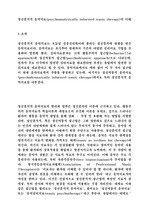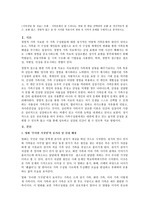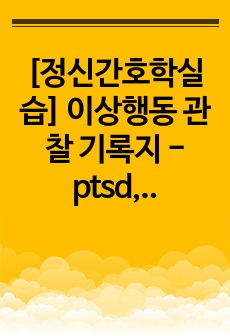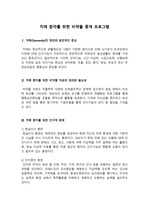

-
미리보기
목차
1.소개
2.정신분석적 접근법 역사와 이론
1) 주요 정신분석의 이론
2) 예술심리치료와 창의적 활동의 의미
3) 정신분석적 음악치료의 배경 및 역사
4) 주요 정신분석 개념과 음악의 관계
3. 정신분석적 음악치료의 특성
1) 정신분석적 음악치료의 목적 및 목표
2) 구조 및 과정
3)자유즉흥연주(free improvisation)
4) 정신분석적 음악치료사의 요건
5)정신분석적 음악치료의 모델
6) 사례연구
4. 맺는말본문내용
정신분석적 음악치료는 오늘날 심층심리학이라 불리는 정신분석에 영향을 받은 음악치료이다. 음악치료는 초기부터 현재까지 기존의 다양한 심리치료 기법을 수용하며 발전해 왔다. 심리치료분야는 크게 행동주의적 접근법(behavior!!al approach)과 정신역동적 접근법(psychodynamic approach)으로 나뉘는데, 전자가 주로 미국에서 발전한 심리치료를 대표한다면 후자는 유럽에서 발전한 심리치료를 대표한다고 할 수 있다. 음악치료에서도 예외 없이 이 두 가지 접근법이 현재 음악치료학의 주류를 형성하고 있는데, 여기서는 정신역동적 음악치료(psychodynamically informed music therapy)에서도 특히 정신분석적 음악치료를 다루겠다.
정신분석적 음악치료의 원리와 철학은 정신분석의 이론에 근거하고 있다. 행동주의적 음악치료가 학습이론과 파블로프의 조건화 이론을 토대로, 겉으로 드러나는 환자의 행동을 음악적 방법을 통해 강화 · 수정 및 보완해 가는 방법을 지향한다면, 정신분석적, 혹은 정신역동적 접근법은 그와 정반대로 겉으로 드러나지 않는 인간의 내면세계와 쉽게 드러나지 않는 무의식적 동기에 주목하고, 음악을 자신의 내면세계를 탐색하고 이해하기 위한 수단으로 사용한다. 정신분석적 접근법에서는 항상 치료사와 환자 간의 관계성을 중시 하는데, 음악은 치료적 관계성을 발전시키고 치료적 변화를 가져오는 매체(music as medium for therapy)라 여긴다. 여기서 치료사는 각 임상상황에 알맞은 숙련되고 창의적인 음악의 사용을 통해 환자와의 상호작용을 확립하고 발전시키고자 노력하며, 이 두 사람이 함께하는 음악적 경험은 곧 치료적 목표의 추구로 이어진다.참고자료
· 김진숙 (1993) 예술심리치료의 이론과 실제. 중앙적성출판사
· 김진아 (1997) 영국 음악치료 사례연구 자폐아 치료를 중심으로. 소아청소년 정신의학. 8권 1호, 123132.
· 김진아 (2000) 집단음악치료에서의 음악과 치료사의 역할. 임상예술 Vol. 11, 3539.
· 김진아 (2003a) 음악적 상호작용과 정서적 의사소통의 의미. 성지재활연구지. 11호, 2536.
· 김진아 (2003b) 사랑 대상관계론과 유아발달 심리학을 통해 본 음악적 상호작용의 의미 고찰. 한국예술치료학회월례발표 Vol 11, 6065.
· Alvarez, A. (1992) Live Company. London: Routledge.
· Alvin, J. (1975) Music Therapy (revised edition). London: John Claire Books.
· Alvin, J. (1978) Music Therapy for the Autistic Child. London: Oxford University Press
· Austin, D. (1999) Vocal Improvisation in Analytically Oriented Music Therapy with Adults. In T. Wigram and J. De Backer (eds) Clinical Application of Music Therapy in Psychiatry. Jessica Kingsley Publishers.
· Bion, W. R.(1962) A theory of thinking. International Journal of Psychoanalysis, Vol. 43, Parts 45.
· Brown, D Peddar, J. (1991) Introduction to Psychotherapy: An outline of psychodynamic principles and practice (2ndedition). Routledge, London.
· Bruscia, K.E. (1998c) An introduction to Music Psychotherapy. In K.E. Bruscia(ed). The Dynamics of Music Psychotherapy. Barcelona Publishers.
· Cawley, R. H (1977) The teaching of psychotherapy, Association of University Teachers of Psychiatry Newsletter January: 1936.
· De Backer, J. (1993) Containment in Music Therapy. In M. Heal and T. Wigram (eds) Music Therapy in Health and Education. London: Jessica Kingsley Publishers.
· De Backer, J. Van Camp, J. (1999) Specific aspects of the music therapy relationship to psychiatry; In T. Wigram and J. De Backer (eds) Clinical Application of Music Therapy in Psychiatry. Jessica Kingsley Publishers.
· Di Franco, G (1993) Music Therapy, A Methodological Approach in the Mental Health Field. . In M. Heal and T. Wigram (eds) Music Therapy in Health and Education. London: Jessica Kingsley Publishers.
· Eliot, L. (1999) Whats going on in there How the brain and mind develop in the first five years of life. A Bantam book.
· Flower, C. (1993) Control and Creativity: Music Therapy with Adolescents in Secure Care. In M. Heal and T. Wigram (eds) Music Therapy in Health and Education. London: Jessica Kingsley Publishers.
· Freud, S. (1901) Fragment of an analysis of a case of hysteria. Standard Edition 7,3. London:Hogarth Press and Institute of PsychoAnalysis.
· Freud, S. (1932/2004) 새로운 정신분석 강의. 임홍빈, 홍혜경 역. 열린 책들. 재간2쇄.
· Glyn, J. (2002) Drummed out of mind: a music therapy group with forensic patients ; In Davies, A. Ricahrds, E (eds) Music Therapy and Group Work: Sound Company. Jessica Kingsley Publishers, London.
· Heal Hughes, M (1995) A comparison of motherinfant interactions and the clienttherapist relationship in music therapy sessions; In T. Wigram., B. Saperston., R. West(eds) The Art Science of Music Therapy: a Handbook. Harwood Academic Publishers.
· IsenbergGrzeda, C., Goldberg, F.S. Dvorkin, J. M. (2004) Psychodynamic approach to music therapy. In A. Darrow(ed) Introduction to Approaches in Music Therapy. American Music Therapy Association, Inc.
· Jones, E. (1953) The Life and Work of Sigmund Freud. Hogarth press. Reprinted in Penguin books 1993.
· Kortegaard, H (1993) Music Therapy in the psychodynamic treatment of schizophrenia; In M. Heal T. Wigram (eds) Music therapy in health and education. Jessica Kingsley Publishers.
· Langenberg, M., Aigen, K. and Frommer, J. (eds) (1996) Qualitative Music Therapy Research, Beginning Dialogues. Gilsum NH: Barcelona Publishers.
· Lecourt, E. (1993) Music Therapy in France. In C. DileoMaranto (ed) Music Therapy: International Perspective. Pennsylvania: Jeffrey Books.
· Levinge, A. (1993) Permission to play; The search for self through music therapy research with children presenting with communication difficulties. In H. Payne(ed). Handbook of Inquiry in the Arts Therapies. Jessica Kingsley Publishers.
· Metzner, S. (1999) Psychoanalytically informed music therapy in psychiatry; In T. Wigram J. De Backer (eds) Clinical Application of Music Therapy in Psychiatry. Jessica Kingsley Publishers.
· OdellMiller, H (2001) Music Therapy and its Relationship to Psychoanalysis; In Y. Searle. I. Streng(eds) Where Psychoanalysis Meets the Arts. London: Karnac Books
· OdellMiller, H (2002) One mans Journey and the import!!!!ance of time: Music therapy in an NHS Mental Health Day Center; In A. Davies. E. Ricahrds.(eds) Music Therapy and Group Work: Sound Company. Jessica Kingsley Publishers, London.
· OdellMiller, H (2003) Are Words Enough Music Therapy as an Influence in Psychoanalytic Psychotherapy. In L. King and R. Randall(eds). The Future of Psychoanalytic Psychotherapy. London; Whurr Publishers.
· Pavlicevic, M. (1995) Interpersonal process in clinical improvisation; Towards a subjectively objective systematic definition. In Wigram, Saperston and West (Eds). The Art Science of Music Therapy: A Handbook. Harwood Academic Publisher.
· Pedersen, I. N. (1998) Introduction to Music Therapy as a Primary Treatment Form. Musikterapiklinikken. Aalborg Psykiatriske SygehusAalborg Universitet.
· Priestley, M. (1975) Music therapy in action. London: Constable.
· Priestley, M. (1994) Essays on Analytical Music Therapy. Phoenixville: Barcelona Publishers.
· Priestley, M. Eschen, J. T. (2002) Analytical Music Therpay origin and development. In J. T. Eschen(ed) Analytical music therapy. Jessica Kingsley Publishers.
· Robarts, J. Z. (1996) Music Therapy for autistic children. In Trevarthen, C. et al. Children with autism: Diagnosis and interventions to meet their needs. Jessica Kingsley Publishers.
· Rogers, P. J. (1992) Issues in working with sexually abused clients in music therapy. Journal of British Music Therapy 6, 2, 3~15.
· Scheiby, B.B. (1998) The Role of Musical Transference in Analytical Music Therapy. In K.E. Bruscia (ed) The Dynamics of Music Psychotherapy. Gilsum, NH: Barcelona Publishers.
· Steele, P. H. (1988) Childrens Use of Music Therapy. In Music Therapy one day conference: Music and the Cycle of Life.
· Stern, D. (1985) The Interpersonal World of the Infant a view from psychoanalysis and developmental psychology. New York: Basic Books.
· Streeter, E. (1999a) Definition and Use of the Musical Transference Relationship. In T. Wigram and J. DeBacker(eds) Clinical Application of Music Therapy in Psychiatry. London: Jessica Kingsley Publishers.
· Towse, E. (1997) Group analysis and improvisation. British Journal of Music Therapy 11, 2, 5255.
· Wigram, T., Pedersen, I. N., Bonde, L. O. (2002) A Comprehensive Guide to Music Therapy; Theory, Clinical Practice, Research and Training. London; Jessica Kingsley Publishers.
· Wigram, T. (2004) Improvisation; Methods and Techniques for Music Therapy Clinicians, Educators, and Students. Jessica Kingsley Publishers.
· Winnicott, D. W. (1971) Playing and Reality. New York: Basic Books.
· Woodcock, J (1987) Towards group analytical music therapy. Journal of British Music Therapy, 1, 1622.태그
-
자료후기
Ai 리뷰이 자료를 통해 새로운 지식과 통찰을 얻을 수 있었고, 과제를 를 보완하는 데 큰 도움이 되었습니다. 매우 만족스러웠습니다. 추천할 만한 자료입니다. -
자주묻는질문의 답변을 확인해 주세요

꼭 알아주세요
-
자료의 정보 및 내용의 진실성에 대하여 해피캠퍼스는 보증하지 않으며, 해당 정보 및 게시물 저작권과 기타 법적 책임은 자료 등록자에게 있습니다.
자료 및 게시물 내용의 불법적 이용, 무단 전재∙배포는 금지되어 있습니다.
저작권침해, 명예훼손 등 분쟁 요소 발견 시 고객센터의 저작권침해 신고센터를 이용해 주시기 바랍니다. -
해피캠퍼스는 구매자와 판매자 모두가 만족하는 서비스가 되도록 노력하고 있으며, 아래의 4가지 자료환불 조건을 꼭 확인해주시기 바랍니다.
파일오류 중복자료 저작권 없음 설명과 실제 내용 불일치 파일의 다운로드가 제대로 되지 않거나 파일형식에 맞는 프로그램으로 정상 작동하지 않는 경우 다른 자료와 70% 이상 내용이 일치하는 경우 (중복임을 확인할 수 있는 근거 필요함) 인터넷의 다른 사이트, 연구기관, 학교, 서적 등의 자료를 도용한 경우 자료의 설명과 실제 자료의 내용이 일치하지 않는 경우
함께 구매한 자료도 확인해 보세요!
-
음악치료의 정의와 역사, 음악치료의 이론적 구성(행동주의이론, 게슈탈트이론, 인본주의이론과 음악치료) 7페이지
I. 음악치료의 역사와 정의 원시와 고대 문화에서부터 음악은 종교적 의식과 의술, 그리고 치료의 실제(healing practice)로서 밀접한 관계를 가져 왔다. 즉 아프리카에서는 샤먼(무당 : shaman, 주술사 : witch doctor, 의사 : medicine man, 제사장 : priest)이 질병, 질환을 발견하고 몰아내어 치유하기 위해.. -
면접의 원리(상담 30분 축어록 작성) 5페이지
오늘날 우리사회에서 사람들이 가지고 있는 행복도는 얼마나 될까? 발전된 기술, 선진국이라고 할 수 있는 우리사회에서 사람들은 오늘 하루가 행복하다고 말할수 있을까? 반복된 일상생활, 하루하루 쌓여가는 정신적, 육체적 스트레스로 인하여 많은 사람들은 오늘 하루가 행복하다고 할 수 없을 것이다. 그냥 이 사회에서 살아가기 위해서, 가족을 위해서 그리고 본인.. -
[유아음악치료] 유아음악치료 54페이지
사람들이 궁극적으로 원하는 삶은 몸과 마음이 건강한 삶일 것이다. 마음에 안정을 얻고, 몸에 진정한 건강함을 지니고 사는 사람처럼 행복한 사람은 없으며, 기나긴 길에서 겪어야 하는 수없이 많은 문제 상황과 난관을 건강하게 이겨내는 방법은 우리 삶에서 최대의 과제인지도 모른다. 인간은 누구나 명백하고도 확실한 신체적 요구와 심리적 욕구를 가지고 태어.. -
[음악치료] 음악치료 10페이지
1.음악치료의 정의 음악치료를 간단히 정의하면, 치료를 위한 음악의 사용이라고 할 수 있을 것이다. 음악을 치료의 매개체로 사용하여 정서적, 사회적, 신체적 건강을 증진시키는 치료의 한 형태로서 음악과 과학의 결합으로 이루어진 예술적, 창조적, 과학적인 치료이다. 우리 모두에게 내재되어 있는 음악성(innate musicality, inborn musi.. -
[상담]상담 축어록 6페이지
이 여학생은 상담자가 교생실습에 나간 학교의 학급 학생이다. 평소 굉장히 활발하고 큰소리로 잘 말하고 웃고, 친구들과도 항상 잘 어울린다고 생각하고 있었는데, 이 학생의 상담 문제가 교우 관계여서 조금 놀랐던 기억이 있다. 표면적으로 드러나지 않고 있던 문제라, 혼자서 많은 고민을 해왔었고, 그것이 자신의 성격 탓이라 생각하며 괴로워하고 있었다. 예..
찾으시던 자료가 아닌가요?
지금 보는 자료와 연관되어 있어요!
문서 초안을 생성해주는 EasyAI


















